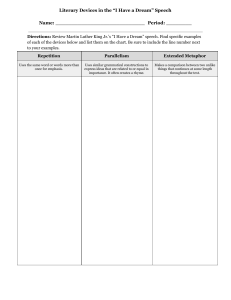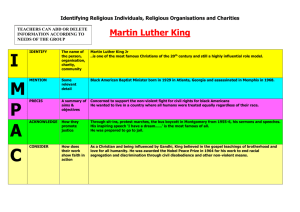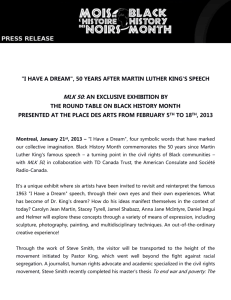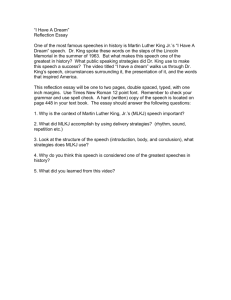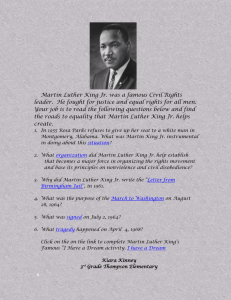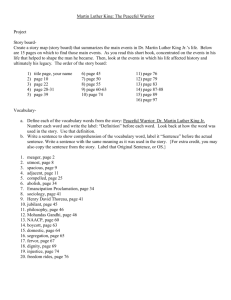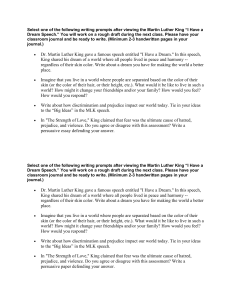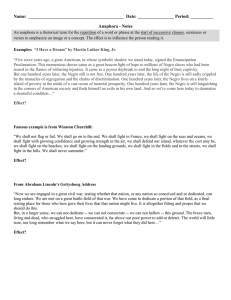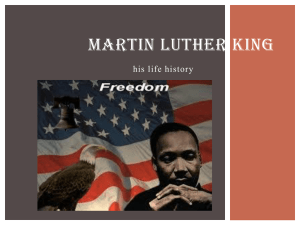*I Have a Dream* * Martin Luther King
advertisement
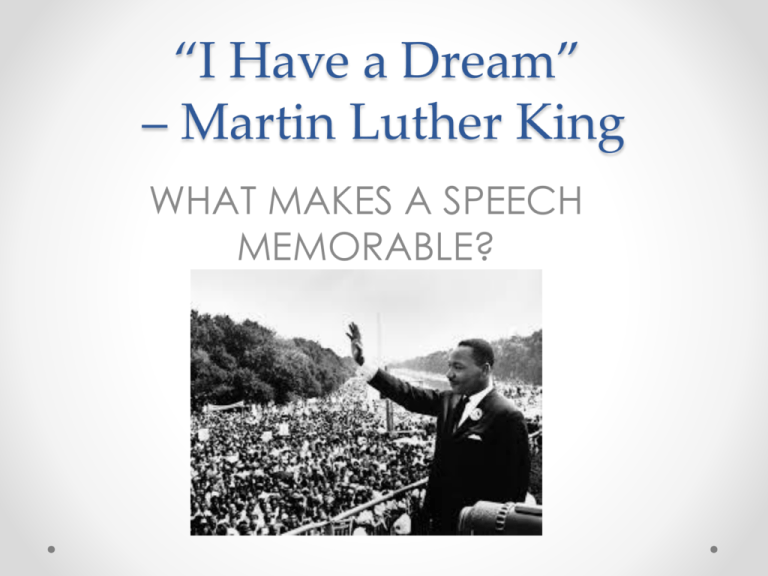
“I Have a Dream” – Martin Luther King WHAT MAKES A SPEECH MEMORABLE? Some new terminology: • RHETORIC o the art of effective or persuasive speaking or writing, especially the exploitation of figures of speech and other compositional techniques. • RHETORICAL DEVICES o a rhetorical device or resource of language is a technique that an author or speaker uses to convey to the listener oa meaning with the goal of persuading him or her towards considering a topic from a different perspective, using sentences designed to encourage or provoke a rational argument from an emotional display of a given perspective or action. Note that although rhetorical devices may be used to evoke an emotional response in the audience, this is not their primary purpose. • ORATOR o a public speaker, especially one who is eloquent or skilled. • Source Wikipedia.com 12/03/15) Speeches can be read critically too! - Context WHEN & WHERE?: On August 28th, 1963, Martin Luther King led a march on Washington D.C for Jobs and Freedom. The speech he gave that day would galvanise the American Civil Rights movement. WHO? Martin Luther King Jr. was a Baptist minister and social activist, who led the Civil Rights Movement in the United States from the mid-1950s until his death by assassination in 1968. WHY? To inspire social change and improve the treatment of AfricanAmericans. STYLE: Martin Luther King was renowned for his oratory and charismatic delivery as a pubic speaker. He relied little on notes and could improvise when needed. “I Have a Dream” • Look and listen to Martin Luther King Jr. deliver his speech. https://www.youtube.com/watch?v=smEqnnklfYs • Use the handout to follow the important parts of the speech and make notes of any techniques that you observe. FAMILIAR TECHNIQUES • • • • ALLITERATION ASSONANCE IMAGERY – METAPHORS & SIMILES INCLUSIVE PRONOUNS Alliteration DEFINITION: The repetition of letters at the start of words **. • “In a sense we have come to our nation’s capital to cash a check.” • “We cannot be satisfied as long as a Negro in Mississippi cannot vote and a Negro in New York believes he has nothing for which to vote. No, no…” ANALYSIS: In this example, both letters and sounds are repeated to makes the speech more memorable. Assonance DEFINITION: Repetition of vowel sounds, for example, “large charge”**. • “We must forever conduct our struggle on the high plane of dignity and discipline.” ANALYSIS: Like alliteration, assonance adds an element of musical poetry to the speech. Extended Metaphors DEFINITION: A comparison made by saying one thing is something else, for example – “The moon was a ghostly galleon”**. • “This momentous decree came as a great beacon light of hope to millions of Negro slaves who had been seared in the flames of withering injustice. It came as a joyous daybreak to end the long night of their captivity.” • “Now is the time to rise from the dark and desolate valley of segregation to the sunlit path of racial justice.” ANALYSIS: In both examples, King equates light with freedom. Simile DEFINITION: A comparison explicitly using the words ‘like’ or ‘as’**. • “We are not satisfied, and we will not be satisfied until justice rolls down like waters and righteousness like a mighy stream.” ANALYSIS: This simile demonstrates the power of justice and righteousness, as well as the belief that equality is a natural thing. It’s also one of the most famous lines of the speech. Inclusive Pronouns DEFINITION: refers to the use of first-person plural pronouns to evoke a sense of commonality and rapport between an orator and his or her audience. • “And when this happens, when we allow freedom to ring, when we let it ring from every village and every hamlet, from every state and every city, we will be able to speed up that day when all of God’s children, black men and white men, Jews and Gentiles, Protestants and Catholics, will be able to join hands and sing.” ANALYSIS: King believes that true justice will only come when every person believes in freedom for all. NEW TECHNIQUES • ANAPHORA • PARALLELISM Anaphora DEFINITION: In writing or speech, the deliberate repetition of the first part of the sentence in order to achieve an artistic effect is known as Anaphora*. This term describes the most famous part of the speech: King’s repetition of “I have a dream.” • “I have a dream that one day this nation will rise up and live out the true meaning of its creed: “We hold these truths to be selfevident: that all men are created equal.” • “I have a dream that one day even the state of Mississippi, a state sweltering with the heat of injustice, sweltering with the heat of oppression, will be transformed into an oasis of freedom and justice.” • “I have a dream that my four little children will one day live in a nation where they will not be judged by the color of their skin but by the content of their character.” ANALYSIS: In King’s speech it constantly reminds the listener of his vision for America’s future and invites them to be involved. Parallelism Parallelism: The repetition of the same grammatical structure , particularly at the beginning of lines. Many examples can be found in the Bible.** • “Go back to Mississippi, go back to Alabama, go back to South Carolina, go back to Georgia, go back to Louisiana, go back to the slums and ghettos of our northern cities, knowing that somehow this situation can and will be changed.” • “With this faith we will be able to work together, to pray together, to struggle together, to go to jail together, to stand up for freedom together, knowing that we will be free one day.” ANALYSIS: The use of parallelism reminds the listener that they are part of a larger struggle and have a role to play. REFERENCES *<http://literarydevices.net/allusion/> accessed on 13/03/2015 **Page, Geoff. 80 Great Poems: From Chaucer to Now. UNSW, 2006. <http://blog.flocabulary.com/i-have-a-dreamspeech-analysis-lesson-plan/> accessed on 12/03/15
